|
|
|
MAHTUMKULU. Edited by: ABDURRAHMAN GÜZEL.
Mahtumkulu dîvâni. Türkmence - Türkçe. Prep. by Abdurrahman Güzel, A Duymaz ve digerleri.
New English Original bdg. HC. 4to. (32 x 23 cm). In Turkish and Turcoman. 755, [1] p. Mahtumkulu dîvâni. Türkmence - Türkçe. Prep. by Abdurrahman Güzel, A Duymaz ve digerleri. A very heavy volume. Extra shipping cost will be requested.
|
|
|
MAKAL Mahmout.-
Un village anatolien.-
Récit d'un instituteur paysan. Nouvelle édition augmentée d'une postface. Textes rassemblés et présentés par Guzine Dino. Traduit du turc par O. Ceyrac et G. Dino. Avec 31 illustrations et 2 cartes dans le texte et 36 illustrations hors texte. Nouvelle édition revue, corrigée et augmentée de débats et critiques et un index. Paris. Plon. Terre Humaine. 1985. Gd in-8 (130 x 200mm) cartonnage toile noire sous jaquette illustrée, bandeau conservé, 357 pages. Bon exemplaire.
Referentie van de boekhandelaar : ORD-6739
|
|
|
MAKAL (Mahmout).
Un village anatolien - Récit d'un instituteur paysan.
P;, Plon, 1978, 1 vol. in-8 (208 x 135) toilé sous jaquette illustrée, de 296 pp. + Catalogue des publications de la collection Terre Humainbe in-fine. Nom d'un ancien propriétaire au stylo sur la page de garde, bel exemplaire.
Referentie van de boekhandelaar : 7994
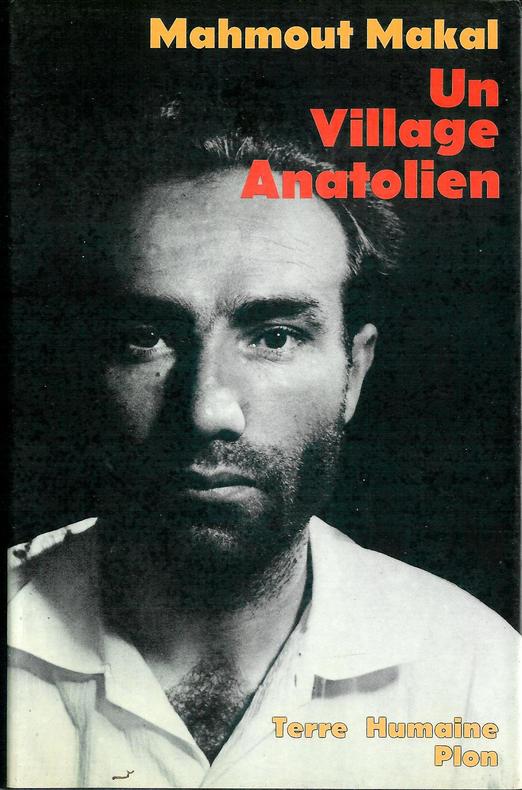
|
|
|
MAKAL, Mahmout.
Un village anatolien. Récit d’un instituteur paysan. Nouvelle édition augmentée d’une postface. Collection Terre Humaine.
Paris, Plon 1978, 208x135mm, 287pages, reliure d'éditeur sous jaquette. Exemplaire à l'état de neuf.
Referentie van de boekhandelaar : 69598
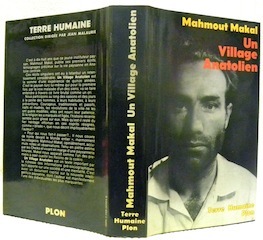
|
|
|
MAKAL MAHMOUT
Un village anatolien
Plon Plon Terre humaine 1963. In-8 broché de 292 pages illustrées. Jaquette. Bon état
Referentie van de boekhandelaar : 107891
|
|
|
Makridi, Theodor
Une citadelle archaique du Pont. Fouilles du Musée Impérial Ottoman par Th. Macridy-Bey. Mit 17 Tafeln. (= Mitteilungen der Vorderasiatischen Gesellschaft. 1907. 4. / 12. Jahrgang).
Berlin: Wolf Peiser 1907. 9 Seiten; mit 17 (überwiegend photographischen) Abbildungen auf Tafeln. 8° (17,5-22,5 cm). Orig.-Broschur. [Softcover / Paperback].
Referentie van de boekhandelaar : 1077170

|
|
|
MALO Charles
Constantinople
Paris [Imprimerie A. Firmin Didot] s.d. [vers 1829] in-12 cartonnage papier vieux-rose gaufré, titre or [Rel. de l'éditeur], usée, petit manque et rest. au dos
Referentie van de boekhandelaar : 7678
|
|
|
MALTE-BRUN
Précis de la géographie universelle ou description de toutes les parties du monde … tome septième seul : Fin de la description de l'Europe.
Couverture souple. Reliure demi-basane. 884 pages. Reliure légèrement défraîchie.
Referentie van de boekhandelaar : 27821
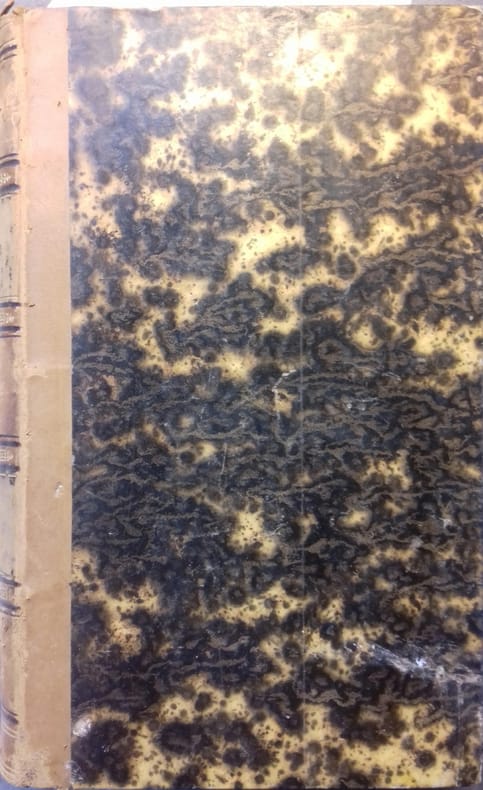
|
|
|
MALCOLM Noel
Useful Enemies: Islam and The Ottoman Empire in Western Political Thought, 1450-1750
8vo, cloth in dj, pp.512. From the fall of Constantinople in 1453 until the eighteenth century, many Western European writers viewed the Ottoman Empire with almost obsessive interest. Typically they reacted to it with fear and distrust; and such feelings were reinforced by the deep hostility of Western Christendom towards Islam. Yet there was also much curiosity about the social and political system on which the huge power of the sultans was based. In the sixteenth century, especially, when Ottoman territorial expansion was rapid and Ottoman institutions seemed particularly robust, there was even open admiration. In this path-breaking book Noel Malcolm ranges through these vital centuries of East-West interaction, studying all the ways in which thinkers in the West interpreted the Ottoman Empire as a political phenomenon - and Islam as a political religion. Useful Enemies shows how the concept of 'oriental despotism' began as an attempt to turn the tables on a very positive analysis of Ottoman state power, and how, as it developed, it interacted with Western debates about monarchy and government. Noel Malcolm also shows how a negative portrayal of Islam as a religion devised for political purposes was assimilated by radical writers, who extended the criticism to all religions, including Christianity itself. Examining the works of many famous thinkers (including Machiavelli, Bodin, and Montesquieu) and many less well-known ones, Useful Enemies illuminates the long-term development of Western ideas about the Ottomans, and about Islam. Noel Malcolm shows how these ideas became intertwined with internal Western debates about power, religion, society, and war. Discussions of Islam and the Ottoman Empire were thus bound up with mainstream thinking in the West on a wide range of important topics. These Eastern enemies were not just there to be denounced. They were there to be made use of, in arguments which contributed significantly to the development of Western political thought.
|
|
|
MALI ILMIHAL: CATECHISM IN ALJAMIADO.
[ONGOING BOSNIAN ALJAMIADO CULTURE IN THE MODERN TIMES] Mâli ilm-i hâl. [= Mali ilmihal]. Ud merhûm Suleimana Murselâ. Sa uvudum u Arabije ud salha abdija te dudatkum perikladinug shetiva za ubradu ahlâka. Trece popravljeno izdanje Vakufskog ravnateljstva u Sarajevu.
Very Good Serbo-Croatian Paperback. Roy. 8vo. (23 x 15 cm). In Aljamiado (Serbo-Croatian in Arabic letters), Arabic, and Persian with an introduction in Arabic. The third revised edition of the Waqf Directorate in Sarajevo. 104 p., 4 unnumbered b/w plates. "Ilmihal" [i.e. Catechism] recommended to all who want to know and learn Islamic ceremonies and practice. Learn how to pray, what are basic principles of the Islamic faith, what are the Islamic duties, what are the Islamic holidays, what constitutes proper Islamic behavior, and lots more. This extremely rare catechism book printed in Sarajevo in Croatian with Arabic letters (Aljamiado). This book is one of the late examples of Aljamiado literature beginning in early Andalusia and constitutes one of the rarest examples of the Ottoman book tradition. Aljamiado or Aljamía texts are manuscripts that use the Arabic script for transcribing European languages, especially Romance languages such as Mozarabic, Portuguese, Spanish or Ladino, and Bosnian with its Arebica script. According to Anwar G. Chejne, Aljamiado or Aljamía is "a corruption of the Arabic word ?ajamiyah (in this case it means foreign language) and, generally, the Arabic expression ?ajam and its derivative 'Ajamiyah are applicable to peoples whose ancestry is not of Arabian origin". During the Arab conquest of Persia, the term became a racial pejorative. In linguistic terms, the Aljamía is the use of the Arabic alphabet to transcribe a Romance language. It was used by some people in some areas of Al-Andalus as an everyday communication vehicle, while Arabic was reserved as the language of science, high culture, and religion. The systematic writing of Romance-language texts in Arabic scripts appears to have begun in the fifteenth century, and the overwhelming majority of such texts that can be dated belong to the sixteenth century. A key aljamiado text was the mufti of Segovia's compilation Suma de los principales mandamientos y devediamentos de nuestra santa ley y sunna, of 1462. In later times, Moriscos were banned from using Arabic as a religious language and wrote in Spanish on Islamic subjects. Examples are the Coplas del alhichante de Puey Monzón, narrating a Hajj, or the Poema de Yuçuf on the Biblical Joseph (written in Aragonese). Aljamiado played a very important role in preserving Islam and the Arabic language in the life of the Moriscos. After the fall of the last Muslim kingdom on the Iberian peninsula, the Moriscos (Andalusian Muslims in Granada and other parts of what was once Al-Andalus) were forced to convert to Christianity or leave the peninsula. They were forced to adopt Christian customs and traditions and to attend church services on Sundays. Nevertheless, some of the Moriscos kept their Islamic belief and traditions secretly through the usage of Aljamiado. In 1567, Philip II of Spain issued a royal decree in Spain, which forced Moriscos to abandon using Arabic on all occasions, formal and informal, speaking and writing. Using Arabic in any sense of the word would be regarded as a crime. They were given three years to learn the language of the Christian Spanish, after which they would have to get rid of all Arabic written material. Moriscos translated all prayers and the sayings of their prophet Mohammed into Aljamiado transcriptions of the Spanish language while keeping all Qur'anic verses in the original Arabic. Aljamiado scrolls were circulated amongst the Moriscos. Historians came to know about Aljamiado literature only in the early nineteenth century. Some of the Aljamiado scrolls are kept in the Spanish National Library in Madrid. The word aljamiado is sometimes used for other non-Semitic languages written in Arabic letters. For example, Bosnian and Albanian texts written in Arabic script during the Ottoman period have been referred to as aljamiado. However, many linguists prefer to limit the term to Romance languages, instead of using Arebica to refer to the use of Arabic script for Slavic languages... Not in OCLC.
|
|
|
MALIK YILMAZ, IBRAHIM GÖKSEL BAYKAN.
Türk kütüphaneciliginde önemli bir adim: Devr-i Hamîdî kataloglari.
New Turkish Paperback. Demy 8vo. (21 x 14 cm). In Turkish. 156 p. Türk kütüphaneciliginde önemli bir adim: Devr-i Hamîdî kataloglari. Catalog of books prepared during Sultan Abdülhamid II reign.
|
|
|
MALMISANIJ.
Cemilpasazadeyen Diyarbekiri u Neteweperweriya Kurdi.
As New English Paperback. Pbo. Mint. Cr. 8vo. (20 x 14 cm). Ills. In Kurdish. 488 p. Cemilpasazadeyen Diyarbekiri u Neteweperweriya Kurdi.
|
|
|
MALMÎSANIJ & MAHMÛD LEWENDÎ.
Li Kurdistana bakur û l Tirkiyê rojnamegeriya Kurdî, (1908-1992).
Fine Kurdish Paperback. Cr. 8vo. (20 x 14 cm). In Turkish. 464, [1] p., b/w ills. Li Kurdistana bakur û l Tirkiyê rojnamegeriya Kurdî, (1908-1992).", MALMÎSANIJ & MAHMÛD LEWENDÎ, Öz-Ge, Ank., 1992. -- Kürtler Kürt sorunu Cumhyriyet Türkiye'si Gazetecilik Basin.
|
|
|
MALMÎSANIJ.
Diyarbekirli Cemilpasazadeler ve Kürt milliyetçiligi. Prep. by Abdullah Keskin.
Fine English Paperback. Pbo. Demy 8vo. (21 x 14 cm). In Turkish. 507 p., b/w ills. Kurdish nationalism and Cemilpasazade family. Diyarbekirli Cemilpasazadeler ve Kürt milliyetçiligi. Prep. by Abdullah Keskin.
|
|
|
MAMBOURY, Ernest
Istanbul touristique. édition française mise à jour à fin mars 1951
Galata-Istanbul, Cituri Biraderler Basimevi 1951 In-8 20 x 11,5 cm. Cartonnage éditeur percaline grise, report auteur & titre en noir sur le dos et le premier plat de couverture orné d’un motif représentant une mosquée en bord de mer, 630 pp., 1 plan replié en couleurs d’Istanbul, 300 illustrations, plans, cartes, vues panoramiques, bibliographie, table des illustrations, table des matières. Exemplaire en bon état.
Referentie van de boekhandelaar : 133748

|
|
|
MAMBOURY Ernest
Constantinople. Guide touristique. 1?re ?dition. Mise ? jour jusqu'? l'automne 1924. 300 illustrations, vues panoramiques, cartes...
Reli?. 565 pages. 1 plan r?par?. 13x19cm.
|
|
|
Mamboury Ernest
Istanbul Touristique
12x18.3 cartonnage gris de l'éditeur, motif représentant une mosquée en bord de mer sur le premier plat, publicité sur le second plat 630p ; un feuillet d'erratum ; bel ex le grand plan en couleurs replié d'Istanbul et autres 300 illustrations plans cartes dessins, vues panoramiques delpiants.etc. edition française mise a jour a fin mars 1951
|
|
|
MANESSON-MALLET, Allain
Description de l'Univers : Afrique ancienne et moderne. Tome III
Francfort sur le Main, Jean David Zunner,1685, 1 volume (sur 5)., 8vo., 4ff-140pp.-6ff.-99 planches*, relié plein veau époque, dos à nerfs orné avec titre et tomaison, filets à froid aux plats, ex-libris en page de garde quelques frottements
Referentie van de boekhandelaar : PHO-1709

|
|
|
MANESSON-MALLET
DESCRIPTION DE L'UNIVERS. Extrait du TOME III Europe (édition originale de Paris 1683). Chapitre IX TURQUIE D'EUROPE et Chapitre X ILES DE L'ARCHIPEL GRECE.
(Paris chez Denys Thierry 1683). Petit in-8 paginé 109 à 209. Cartonnage bradel du XIXe siècle de papier ocellé rouge, jaune, bleu, pièce de titre grenat en long sur le dos "Manesson-Mallet Balkans, Turquie d'Europe". Orné de 49 planches à pleine page numérotées XLV à XCIV composées de 1 portrait, 1 plan, 4 de costumes, 10 vues et 33 cartes, toutes colorées à l'époque. Manques de papier en tête et en queue du dos du cartonnage, occasionnant la fragilité du mors du 1er plat, intérieur complet pour les sujets traités et de la plus grande fraîcheur. CHAPITRES IX ET X EXTRAITS DU TOME III DE L'EDITION ORIGINALE PARUE EN 1683 *chapitre IX Turquie d'Europe paginé 109 à 167, intitulé de l'Illyrie et de la Grèce selon les Anciens, de la Turquie d'Europe (Septentrionale et Méridionale) *Chapitre X paginé 168 à 209 intitulé des Isles de l'archipel qui sont vers l'Europe (Iles de la Mer Egée, Cyclades et Ioniennes). Toutes planches (appelées ici figures) sont très habilement aquarellées avec de belles teintes vives. Celles qui intéressent directement la Turquie représentent: Portrait du Sultan Mehmet IV, Costume du Grand Turc, Costume traditionnel d'un Turc et d'une Turque, Costume d'un Spahis et de 2 Janissaires (sur une seule planche), Plan de Constantinople, vues de Constantinople, Château des 7 Tours, du Sérail (avant et arrière), Cathédrale-Mosquée Sainte Sophie (2 vues), 4 cartes (Turquie d'Europe Septentrionale, Turquie d'Europe Méridionale). La Grèce est représentée par des cartes (Grèce en général, Grèce en particulier, cartes des Cyclades et des îles Ioniennes de la Mer Egée), 2 vues de Candie (Crète), ville et labyrinthe. Les autres planches ont pour sujet: l'Illyrie; Dace et Thrace; Pannonie et Illyrie; Rhetie et Vindelécie; Moldavie et Transilvanie; Hongrie; Macédoine; Thessalie et Epire; 1 costume traditionnel Hongrois; une vue de Waradin, une de Bude, une de Presbourg, Sestos, Abydos et le Détroit de Gallipoli. 6 cartes sont reproduites 2 fois avec une numérotation différente: XLVI et XLVII (Dace et Thrace), LI et LII (Macédoine, Thessalie, Epire), LXII et LXIII (Turquie Méridionale), LXXVIII et LXXIX (Schiro et Nègrepont), LXXX et LXXXI (Andro et Tiré), LXXXIX et XC (île de Candie). CE FRAGMENT COMPLET POUR LES SUJETS TRAITES PERMET D'APPR2CIER LA FINESSE ET LA BEAUTE DES FIGURES DE L'OUVRAGE DE MANESSON-MALLET.
Referentie van de boekhandelaar : GITj822

|
|
|
MANTRAN Robert
HISTOIRE DE LA TURQUIE
1993 broché in-octavo tellière, dos blanc, couverture bleue, quelques passages du texte sont soulignés, illustrations hors-texte, 128 pages, 1993 Paris Presse Universitaires de France,
Referentie van de boekhandelaar : 8675
|
|
|
MANTRAN R
HISTOIRE DE L'EMPIRE OTTOMAN
(ISBN : 9782213019567) FAYARD, 1998.
Referentie van de boekhandelaar : 2118
|
|
|
Mantran Robert
Histoire de l'Empire Ottoman
Fayard, coll. « Biographies Historiques » 1989 In-8 cartonnage éditeur souple 24 cm sur 15. 810 pages. Très bon état d’occasion.
Referentie van de boekhandelaar : 105092
|
|
|
Mantran, Robert
Histoire d'Istanbul
Fayard 1997 In-8 broché. 382 pages. Bon état d’occasion.
Referentie van de boekhandelaar : 107772
|
|
|
MANTRAM Robert
Histoire d'Istanbul.
Paris, Fayard, 1996. 16 x 24, 382 pp., quelques illustrations en N/B, broché, bon état.
Referentie van de boekhandelaar : 80110
|
|
|
MANTRAN Robert
Histoire d'Istanbul. Collection : Histoire des grandes villes du monde.
Paris, Fayard, 1996. 16 x 24, 382 pp., nombreuses illustrations, broché, couverture à rabats, très bon état (cachet ex-particulier).
Referentie van de boekhandelaar : 84355
|
|
|
MANTRAN Robert
Histoire de la Turquie. Collection : Que sais-je ?, N° 539.
Paris, Presses Universitaires de France (PUF), 1993. 11 x 18, 128 pp., 1 carte, broché, très bon état (1 cachet et 1 signature ex particulier).
Referentie van de boekhandelaar : 84646 ISBN : 2130455964
|
|
|
MANTRAN, Robert
Istanbul, au siècle de Soliman Le Magnifique
Paris, éd. Le Grand livre du mois, 1995, in-8, cartonnage souple, couv. ill. coul. éd., 350 pp., bibliographie, notes, glossaire, table des matières, L'histoire de l'empire ottoman sous le rène de Soliman le Magnifique au XVIe siècle. Très bon état
Referentie van de boekhandelaar : 73097
|
|
|
MANTRAN (Robert).
La Vie quotidienne à Constantinople au temps de Soliman le Magnifique et de ses successeurs (XVIe et XVIIe siècles).
Hachette, 1965 in-8°, 319 pp, 2 cartes, biblio, cart. éditeur, jaquette illustrée, bon état
Referentie van de boekhandelaar : 9576
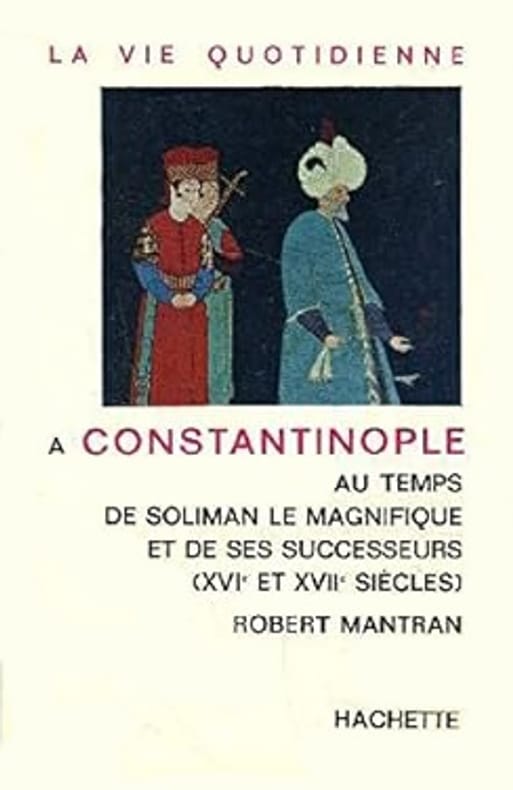
|
|
|
MANTRAN (Robert)
La vie quotidienne à Istanbul au siècle de Soliman le Magnifique
Hachette 1990, in-12 broché, 332 p. (bel état ; épuisé) Notes et glossaire. Edition mise à jour d'un classique de la collection, paru pour la première fois en 1965.
Referentie van de boekhandelaar : 45527
|
|
|
MANTRAN Robert,
La vie quotidienne à Constantinople au temps de Soliman le Magnifique et de ses successeurs (XVIe et XVIIe siècles),
Hachette, 1965, 319 pp., relié, jaquette un peu défraîchie, légères traces d'usage, état très correct.
Referentie van de boekhandelaar : 63466

|
|
|
MANESSON MALLET (Alain)
Les Travaux de Mars. ou l'Art de la Guerre. Divisé en trois parties. La première enseigne la méthode de fortifier toutes sortes de places régulières & irrégulières. - La seconde explique leurs constructions, selon les plus fameux auteurs, qui en ont traité jusqu'à présent, & donne aussi la manière de les bâtir. - La troisième, enseigne les fonctions de la cavalerie & de l'infanterie, traite de l'artillerie, & donne la méthode d'attaquer et de deffendre les places. Avec un ample détail de la milice des Turcs, tant pour l'attaque que pour la défense. Ouvrage enrichi de plus de quatre cens planches gravées en taille-douce. Dédié au Roy
Paris, Denys Thierry, 1685 (1684)-1684 3 vol. in-8, veau brun granité, dos à nerfs cloisonnés et fleuronnés, tranches mouchetées (reliure de l'époque). Disparate de fers entre les vol. I & II d'une part, III d'autre part, toutes coiffes rognées, des mors fendus, des mouillures claires, surtout au vol. III.
Referentie van de boekhandelaar : 221955
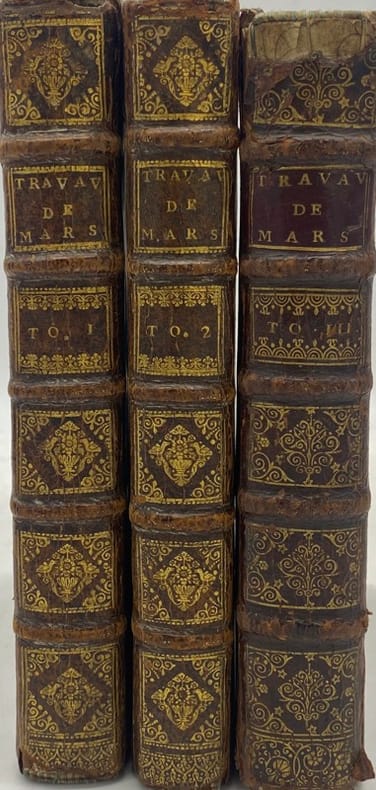
|
|
|
MANESSON MALLET (Alain)
Les Travaux de Mars. ou l'Art de la Guerre. Divisé en trois parties. La première enseigne la méthode de fortifier toutes sortes de places régulières & irrégulières. - La seconde explique leurs constructions, selon les plus fameux auteurs, qui en ont traité jusqu'à présent, & donne aussi la manière de les bâtir. - La troisième, enseigne les fonctions de la cavalerie & de l'infanterie, traite de l'artillerie, & donne la méthode d'attaquer et de deffendre les places. Avec un ample détail de la milice des Turcs, tant pour l'attaque que pour la défense. Ouvrage enrichi de plus de quatre cens planches gravées en taille-douce. Dédié au Roy
Paris, Denys Thierry, 1685 (1684)-1684 3 vol. in-8, veau brun granité, dos à nerfs cloisonnés et fleuronnés, double filet doré en encadrement sur les plats, tranches mouchetées (reliure de l'époque). Dos habilement restauré.
Referentie van de boekhandelaar : 233832
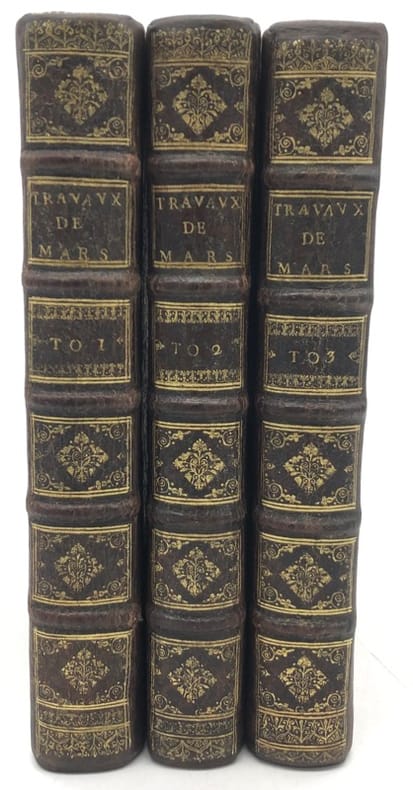
|
|
|
MANTRAN (Robert).
Turquie. Texte de R. Mantran, photographies de Emile Dahier et Emmanuel Boudot-Lamotte.
Hachette, 1955, in-8° carré, 126 pp, 62 pl. en noir et 8 pl. en couleurs hors texte, une carte, reliure de l'éditeur, jaquette illustrée, bon état, ex. du SP (Coll. Les Albums des Guides Bleus)
Referentie van de boekhandelaar : 97521
|
|
|
MANTRAN, Robert.
Turquie. Photographies de Emile DAHER et E. BOUDOT-LAMOTTE
Paris, Hachette (« Les Albums des Guides Bleus, n° 7 »), 1955. in-8°,, 126 pp., photos hors-texte (62 N&B + VIII coul.), relie plein Skivertex bleu decor ed., jaquette illustree.
Referentie van de boekhandelaar : 19968
|
|
|
MANAKIS BROS.
The proclamation of freedom in Manastir, (1908-1909). The Manakis Brothers.= Manastir'da ilân-i hürriyet, (1908-1909). Fotografçi Manakis Biraderler. Edited by Roni Margulies. Foreword by Zafer Toprak. Trans. by Alan Duben.
New New English Original bdg. Dust wrapper. Oblong 4to. (24 x 34 cm). In English and Turkish. 18, [66] p., b/w photos. 1000 copies were printed. The proclamation of freedom in Manastir. The Manakis Brothers.= Manastir'da ilân-i hürriyet. Fotografçi Manakis Biraderler. Edited by Roni Margulies. Foreword by Zafer Toprak. Trans. by Alan Duben. "The Manakis Brothers, Yanakis (1878-1960) and Milton (1882-1964) set up their first photography studio in Yanya (the present-day Greek city of Ioanna) in 1898. For six years they photographed the well-to-do of Yanya, the local notables and their women. Few had the means to have their photographs taken in those years. It was a very costly way of showing off.".
|
|
|
MANASTIRLI MEHMED TEVFIK B. YUSUF.
Takvîmü's-sinîn.
Very Good Turkish, Ottoman (1500-1928) Paperback. Cr. 8vo. (20 x 14 cm). In Ottoman script. 34, [1] p. First Edition. Hegira: 1324 = Gregorian: 1908. Özege 19591.; Only one copy in OCLC: 1030753547 (Orient-Institut Istanbul).
|
|
|
MANAVOGLU NEVRES BEY.
Merkad-i Osman'da Yunan süngüsü.
Fine English Paperback., Fine., 20 x 14 cm, 160 p. "Merkad-i Osman'da Yunan süngüsü., MANAVOGLU NEVRES BEY, Haz: Orhan Hülagü - Ayse Raziye Özalp, Emre Yayinlari, Istanbul, 2001"
|
|
|
MANFRED PITTIONI.
Das Osmanische Heerwesen im 15. und 16. Jahrhundert Organisation, Taktik und Ausrustung.
As New English Paperback. Pbo. Mint. Roy. 8vo. (24 x 17 cm). In German. [4], 103 p. Das Osmanische Heerwesen im 15. und 16. Jahrhundert Organisation, Taktik und Ausrustung. I. Einleitung. II. Das Entstehen des Osmanischen Heeres-Von Stammeskriegern zu Soldaten. III. Bewaffnung und Ausrüstung. N. Strategie und Taktik. V. Logistik, Mobilisierung und Finanzierung. VI. Ideologischer Überbau der osmanischen Militärpolitik., VII. Beginn von "Verfallserscheinungen" Ende des 16. Jahrhunderts? VIII. Schlußbemerkungen. IX. Zur Wiedergabe osmanisch-türkischer. Eigennamen und Wörter. X. Literaturliste. XI. Index. OTTOMANIA Military history 15th century.
|
|
|
MANFRED PITTIONI.
Das Osmanische Heerwesen im 15. und 16. Jahrhundert Organisation, Taktik und Ausrustung.
New English Paperback. Pbo. Roy. 8vo. (24 x 17 cm). In German. [4], 103 p. Das Osmanische Heerwesen im 15. und 16. Jahrhundert Organisation, Taktik und Ausrustung. I. Einleitung. II. Das Entstehen des Osmanischen Heeres-Von Stammeskriegern zu Soldaten. III. Bewaffnung und Ausrüstung. N. Strategie und Taktik. V. Logistik, Mobilisierung und Finanzierung. VI. Ideologischer Überbau der osmanischen Militärpolitik., VII. Beginn von "Verfallserscheinungen" Ende des 16. Jahrhunderts? VIII. Schlußbemerkungen. IX. Zur Wiedergabe osmanisch-türkischer. Eigennamen und Wörter. X. Literaturliste. XI. Index. OTTOMANIA Military history 15th century.
|
|
|
Mango,Andrew
Turkey
[New Nations and Peoples library] Surveys the development of modern Turkey in the 20th.C since the collapse of the Ottoman Empire. 192p. plates illus map bibliography, index Book
|
|
|
Manière-Lévêque, A.-M.
Corpus of the mosaics of Turkey. Volume II: Xanthos. Part 2: The West area.
New English Original bdg. HC. 4to. (32 x 24,5 cm). In English. 131 p. Color and b/w ills. Corpus of the mosaics of Turkey. Volume II: Xanthos. Part 2: The West area. The present book forms the second volume in the Corpus of the Mosaics of Turkey, following upon the initial work on Xanthos published by Marie-Patricia Raynaud in 2009. This new volume broadens the documentation and appreciation of mosaic art in that city. Future monographs in the same series will turn to other archaeological sites in Turkey, whose vast mosaic treasures are gradually receiving the scholarly attention they deserve. This entire project originated at a meeting of mosaic experts from six countries led by M. Sahin and D. Parrish and held at the American Research Institute in Turkey at Istanbul in 2004. In this work, Anne-Marie Manière-Lévêque, a very experienced member of the French team that has been excavating at Xanthos for many years, carefully records and interprets mosaic pavements from the western part of Xanthos, which includes buildings with mosaic decoration on the Lycian Acropolis and in the "Roman" Agora. The pavements ornamented both domestic and religious structures, and they include several fine figural carpets in addition to geometric floors. The pavement techniques consist of both opus tessellatum and opus sectile, and chronologically they cover the late Antique and Early Byzantine periods. These floors complement the fine assortment of pavements found in the East Basilica inventoried in the first Xanthos volume. In both its text and rich illustration, the present work maintains the high standard of scholarship employed in the earlier volume, and all of this is underscored by the author's deep familiarity with the archaeological exploration of Xanthos. Both books in the series serve as models for future mosaic research in Turkey. ARCHEOLOGY Anatolian civilizations Mosaic History of art.
|
|
|
Mansel Philip
Constantinople: City of the World's Desire 1453-1924
pp. 544.
|
|
|
Mansel Philip
Constantinople: City of the World's Desire 1453-1924
8vo., pp.xvi-528 with 60 plates; black cloth, gilt back in dust jacket
|
|
|
Mansel Philip
Constantinople: City of the World's Desire, 1453-1924
pp.xvi-528, 33 b.w. illustrations.
|
|
|
Mansel Philip
Levant: Splendour and Catastrophe on the Mediterranean
br. ed. 480pp. Levant is a book of cities. It describes Smyrna, Alexandria and Beirut when they were windows on the world, escapes from nationality and tradition, centres of wealth, pleasure and freedom. Using unpublished family papers, Philip Mansel describes their colourful, contradictory history, from the beginning of the French alliance with the Ottoman Empire in the sixteenth century to their decline in the mid twentieth century. Smyrna was burnt; Alexandria Egyptianised; Beirut lacerated by civil war.

|
|
|
Mansel, Philip
Constantinople: City of the World's Desire, 1453-1924
Mansel's sweeping narrative of the last five centuries of Constantinople reinterprets the history of the Ottoman Empire and provides an enthralling biography of "the city of the world's desire". "This is a work for the general reader which will also earn the admiration of all academic specialists in Ottoman history" 528p. bibliography index. Clean crisp tight copy Large format softcover weighs over 2 lbs. Book
|
|
|
Mansel, Philip
Sultans in Splendour : The Last Years of the Ottoman World
Large format book. Sultans, Shahs, Khedives, Pashas - and their Harems - described with lavish illustrations of the people, places and possessions from 1869 though the later years of the Ottoman Empire. 192p. bibliography. index. Text crisp and neat. usual library marks, laminated SDH Ex-Library
|
|
|
MANTRAN ROBERT
Histoire de la Turquie
Puf 1975. In-12 broché de 127 pages. Collection Que sais-je. Très bon état
|
|
|
MANTRAN Robert
Histoire de la Turquie.
Broché. 128 pages. Format de poche.
|
|
|
MANTRAN Robert
Istanbul au siècle de Soliman le Magnifique
Grand Livre du Mois 1998. In-8 relié cartonnage souple éditeur, 348 pages. Très bon état

|
|
|